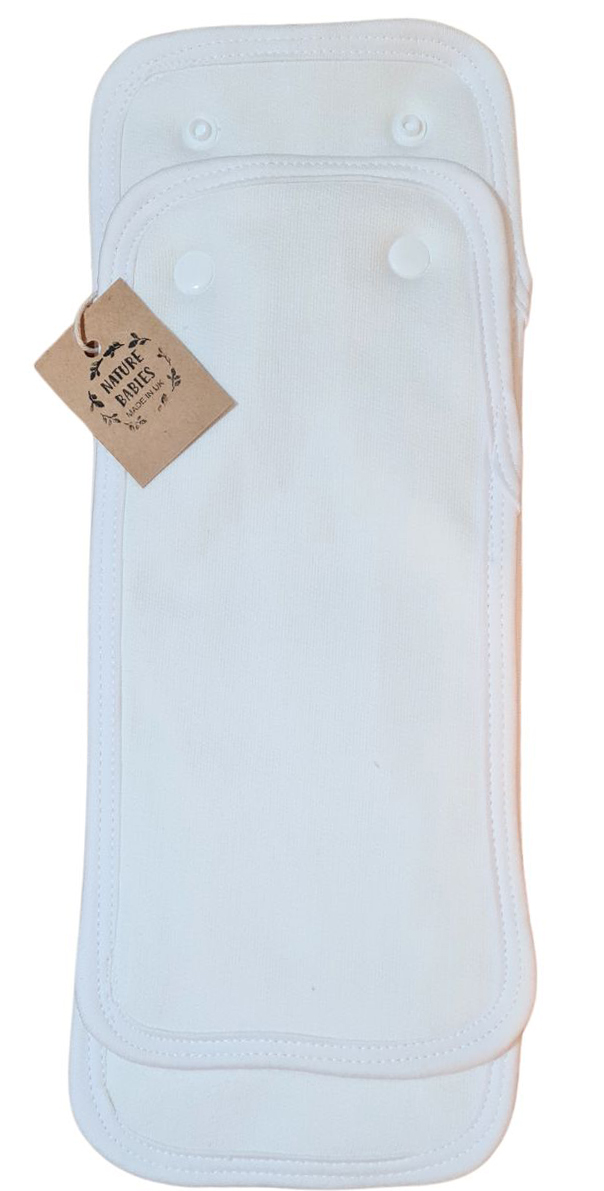Two Part Nappy Systems
These comprise an absorbent NAPPY for use with a separate waterproof WRAP.

Wraps
So far all the nappy types above that I've mentioned need WRAPS
You will expect to need about 4 wraps per size, possibly more with a breastfed newborn as even with being very careful when taking nappies off it can be quite easy to get poo on a wrap despite your best intentions! This allows you to use a wrap for three or four nappy changes before washing. Always wash if soiled, and in the interests of longevity of the waterproof properties I recommend washing if the wrap becomes very wet with urine. Different manufacturers wraps come in different sizes, and consequently have varying amounts of adjustment. Some wraps have gussetted legs, which can mean a better fit on some babies, particularly if slim. Generally there are 3 ways of fastening: pull-ons, which do literally that. Velcro, which will provide the most adjustable and snuggest fit. Thirdly, the looser fitting popper fastening which allows ventilation between the poppers, is hard for toddlers to undo, and can also be used as a pulll on. You can wash all wraps at 40ºC other than a wool wrap which requires a 30ºC (COLD!) wash. However some, as indicated, can be washed at 60ºC with your nappies, which may be of benefit to you, and can be tumble dried.Wraps are made from a variety of fabrics. Waterproof non-breathable ones are made from PVC or nylon, generally these need to be washed at a lower temperature, and especially the PVC are not hard wearing. Breathable wraps are made from a polyurethane laminate, usually laminated to polyester which is nice and soft as well as hard wearing compared to PVC. Some wraps have an outer layer of cotton, which is softer still to touch, and can be nicely patterned. However, with some babies especially, and particularly if the nappy is left on too long or as the wrap is beginning to be outgrown these cotton wraps can allow wicking (movement of moisture from inside onto the outer cover of the wrap). Wool and fleece wraps are also available, and provide a totally breathable cover, definitely cooling the nappy area by allowing a lot of moisture loss by evaporation. However care should be taken with fleece as particularly with a single layer moisture can be pushed through. Also with these wraps if your baby is sat in a (plastic) car seat for any length of time, they can allow moisture ito collect on the outside.One Piece to put on
ALL-IN-ONE, ONE PART NAPPIES These are shaped to fit, like a disposable, and usually fasten with Velcro or Aplix (eg Tots Bots) and a few with poppers (eg Motherease). They are very easy to put on and take off. They comprise an absorbent layer with an integral waterproof wrap. However they are often the slowest nappies to dry because the waterproof layer on one side limits the speed of drying, and thus have largely been superceeded by the pocket nappies (below). They are also generally the most expensive, and where the waterproof layer is washed with the nappy are likely to wear out the soonest - particularly the one-sized versions. Furthermore, as there is effectively only one leg and waist barrier unless the nappy is a good fit this type of nappy may leak. This tends to happen especially with newborn babies and often it's worth waiting a few weeks till the legs have filled out and are less scrawny.
To get round the drying issue of All in Ones, and also - There are also All In Two type nappy systems which get around the drying time problems by being styled as a one-piece affair but having a detachable nappy part from the cover. These have a separate absorbent pad that fastens nto the PUL outer with poppers, such as the Mother-ease Duo. This means the 2 bits can be separated for washing and drying. Cost savings may also be made with these systems as less nappy covers may be needed to absorbent inners because the drying time is considerably reduced.So in which order do I put everything together? It's usually easiest to lay the wrap out first and put everything on top: Wrap, nappy, fleece or flushable liner, baby - see picture aboveor All In One, fleece or flushable liner, baby Boosters: Some babies need extra absorbency, this is added by placing a BOOSTER (sometimes called booster liner) - a pad of cotton (or hemp, bamboo or microfibre) which can be folded and strategically placed depending where your baby wees most. For a better fit, you may also place the booster between the nappy and the wrap rather than inside the nappy. This is particularly relevant with an older baby or toddler where they wee a lot in one go, if the nappy is pushed closer to the baby by the booster being under the nappy then the wee will tend to soak up rather than try to run down the leg and outClick Here for tips on how to choose your nappies Click Here for 'How to Nappy' our booklet detailing how to use cloth nappies








